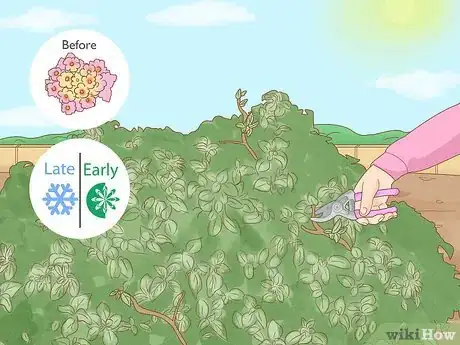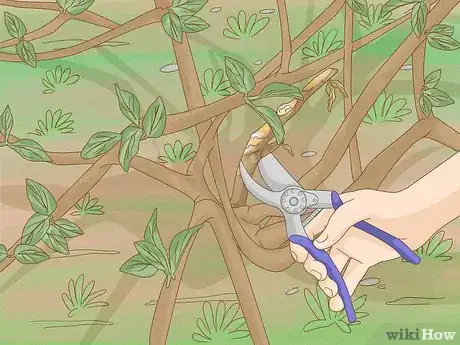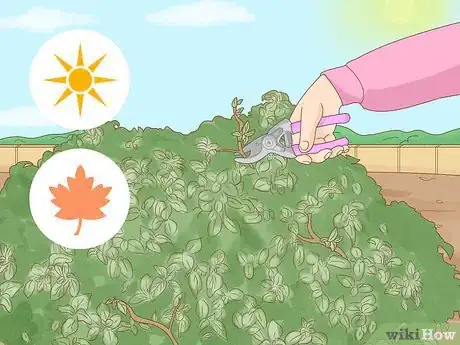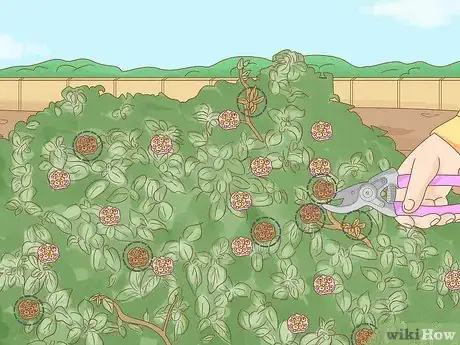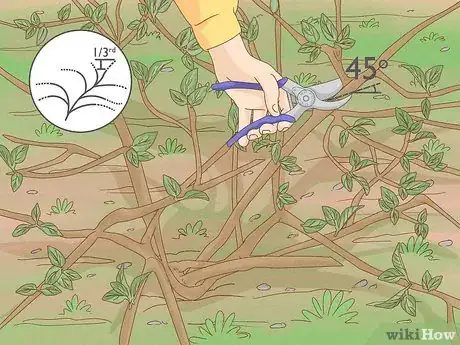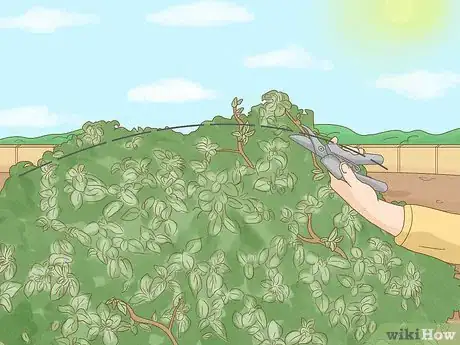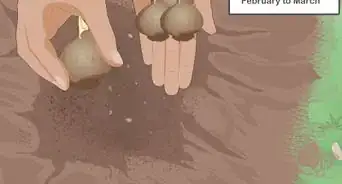X
This article was co-authored by Maggie Moran. Maggie Moran is a Professional Gardener in Pennsylvania.
This article has been viewed 72,443 times.
The lantana plant is a bright, colorful floral shrub that grows best in warm, sunny climates. Pruning is optional with lantana plants, though it helps them grow full, luscious flowers and look their best. If you want to prune your lantanas, trim their stems and remove damaged areas before their growing season in the spring. In addition, you can cosmetically prune your lantana in the summer and fall. Simply grab a pair of pruning shears and make some snips!
Things You Should Know
- Prune in late winter or early spring to stimulate new growth.
- Trim stems down to 6–8 in (15–20 cm) with pruning shears. Make cuts at a 45-degree angle to encourage healthy growth.
- Completely remove any damaged or decaying areas.
- In the summer and fall, prune selectively to shape the plant and get rid of fading flowers, withered stems, and unattractive branches.
Steps
Method 1
Method 1 of 2:
Pruning in the Spring
-
1Prune your lantana before it blooms for best results. Typically, lantana plants bloom through the spring and fall. Trim your plant in the late winter or early spring before it hits the growth period for optimal flower yield.
- While you don’t have to prune your lantana plants, it helps them spur new growth and look great in your garden.
- If you live in the Northern Hemisphere, you can prune your lantana plants in June.
-
2Trim the stems of your plant to 6–8 in (15–20 cm) to rejuvenate it. If you want to trigger new growth, cut all of the stems to about 6–8 in (15–20 cm). Use pruning shears, and make your cuts at a 45-degree angle.
- The fresh cuts encourage the plant to grow new stems and leaves.
- Cutting your stems at a 45-degree angle helps the plant recover from the wound more quickly and stay healthy.
Advertisement -
3Cut away damaged areas to keep your lantana healthy. If you notice any damaged or decaying areas on your plants due to frostbite or other problems, it is best to remove them while pruning in the spring. To do this, line your pruning shears up to the stem at the start of the discoloration, and make a clean snip at a 45-degree angle.[1]
- You can cut the damaged stems down to the ground or leave them between 1⁄2–1 ft (0.15–0.30 m), based on your personal preference. If you want a shorter shrub, chop it to the ground.
- This way, your plant will not waste any valuable nutrients on withered stems.
Advertisement
Method 2
Method 2 of 2:
Trimming after the Growth Period
-
1Prune selectively in the summer and fall to shape your plants. If you’d like to shape your lantana plant as it grows, you can cosmetically prune it during the growth season. While this is not required, it helps your plant maintain its shape, fit in the garden bed or container, and look attractive.
- Lantana plants grow very quickly, so feel free to trim your plant as you see fit.
-
2Remove any fading flowers, withered stems, and unattractive branches. Start at the bottom of your plant and begin trimming away any discolored flowers, brown or yellow stems, and long branches. Use pruning shears to make your cuts. Make your snips along the stem at a 45-degree angle to encourage healthy growth. Work your way around the plant until it looks gorgeous and green rather than faded and droopy.[2]
- To remove an entire stem, make your cut at the base of the stem.
- If removing parts of the plant, cut along the stem in between 2 leaves.
-
3Cut your plant down by one-third if it looks unkempt. If your plant looks overgrown, trim around the shrub to get rid of about one-third of its total mass. Make snips around the sides and top of your plant using pruning shears. Snip the stems at a 45-degree angle. Prune your lantana plant until it looks great, based on personal preference.[3]
- If you live in the Northern Hemisphere, this likely occurs by September or October.
- Don't worry about making the shape perfect, as lantanas grow quickly and any uneven areas will soon be filled in.
- For example, if your lantana is outgrowing its garden bed, snip the plant back so it is contained inside the space.
-
4Make small snips around the crown of your plant to clean up the shape. To do this, smooth the crown of your plant by snipping away long branches, extending leaves, and extra flowers. This keeps your lantana plant looking bush-like and controlled. You can do this once in the late summer or early fall or 1-3 times a month, based on your desired look. Position your shears at a 45-degree angle when you make your cuts.[4]
- If you are pruning a vining lantana plant, snip from bottom to top. Pruning vining lantanas helps give them a full, dense appearance.
Advertisement
Expert Q&A
Did you know you can get expert answers for this article?
Unlock expert answers by supporting wikiHow
-
QuestionCan Lantana survive a freeze?
 Maggie MoranMaggie Moran is a Professional Gardener in Pennsylvania.
Maggie MoranMaggie Moran is a Professional Gardener in Pennsylvania.
Home & Garden Specialist
-
QuestionHow often do you water Lantana plants?
 Maggie MoranMaggie Moran is a Professional Gardener in Pennsylvania.
Maggie MoranMaggie Moran is a Professional Gardener in Pennsylvania.
Home & Garden Specialist
-
QuestionHow do you prune hydrangeas?
 Maggie MoranMaggie Moran is a Professional Gardener in Pennsylvania.
Maggie MoranMaggie Moran is a Professional Gardener in Pennsylvania.
Home & Garden Specialist You can prune hydrangeas to either improve the size and vitality of the blooms or for aesthetic reasons. You should prune using appropriate cutting instruments after blooming is complete. While not absolutely necessary, removing dead or faded flowers during the blooming season can make way for new blooms.
You can prune hydrangeas to either improve the size and vitality of the blooms or for aesthetic reasons. You should prune using appropriate cutting instruments after blooming is complete. While not absolutely necessary, removing dead or faded flowers during the blooming season can make way for new blooms.
Advertisement
Warnings
- Always wipe down your pruning shears with alcohol before and after you use them to prevent contamination or the spread of diseases.[6]⧼thumbs_response⧽
Advertisement
References
About This Article
Advertisement
